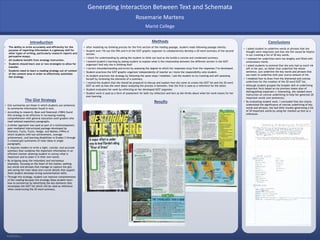More Related Content
Similar to Final Copy of NYSRAC Poster
Similar to Final Copy of NYSRAC Poster (20)
Final Copy of NYSRAC Poster
- 1. RESEARCH POSTER PRESENTATION DESIGN © 2012
www.PosterPresentations.com
• Gist summaries are those in which students use sentences
to summarize information found in text.
• According to research, Bean and Steenwyk (1984) found
this strategy to be effective in increasing reading
comprehension with general education sixth graders who
read isolated expository paragraphs.
• A similar approach was used as part of a multicomponent,
peer-mediated instructional package developed by
Simmons, Fuchs, Fuchs, Hodge, and Mathes (1994) in
which students with low achievement, average
achievement, and learning disabilities in Grades 2 through
5 created gist summaries of main ideas in single
paragraphs.
• It requires readers to write a tight, concise, and accurate
summary that condense the important information in an
efficient manner allowing student to convey what is
important and to state it in their own words.
• By stripping away the redundant and extraneous
examples, focusing on the heart of the matter, seeking
key words and phrases that manage to capture the gist,
and saving the main ideas and crucial details that support
them student develops strong summarization skills.
• Through this strategy, student can improve comprehension
of the reading because this strategy helps student learn
how to summarize by identifying the key elements that
encompass the GIST list which will be used as reference
when constructing the 20 word summary.
Introduction
• The ability to write accurately and efficiently for the
purpose of reporting information is a gateway skill for
other types of writing, particularly research reports and
persuasive essays.
• All students benefit from strategy instruction.
• Students should learn one or two strategies to allow for
transfer.
• Students need to learn a reading strategy out of context
of the content area in order to effectively assimilate
the strategy.
• After modeling my thinking process for the first section of the reading passage, student reads following passage silently.
• Student and I fill out the 5Ws and H of the GIST graphic organizer to collaboratively develop a 20 word summary of the second
section.
• I check for understanding by asking the student to think out loud as she builds a concise and condensed summary.
• I extend student’s learning by asking student to explain what is the relationship between the different section in the GIST
organizer? And why she is thinking that?
• I correct misunderstanding and errors by assessing the degree to which her responses stray from the responses I’ve developed.
• Student practices the GIST graphic organizer independently of teacher as I move the responsibility onto student.
• As student practices the strategy by following the same steps I modeled, I ask the student to try tracking and self-assessing
herself by reviewing the elements of a summary.
• I remind the student that she should be prepared to discuss and explain how she came to create the GIST list and the 20 word
GIST as well as how she went about analyzing the process in between, that the first is used as a reference for the latter.
• Student evaluates her work by reflecting on her developed GIST organizer.
• Student work is used as a form of assessment for both my reflection and hers as she thinks about what her work means for her
own learning.
Methods
Results
Conclusions
• I asked student to underline words or phrases that she
thought were important and that she felt would be helpful
in our creating a list of 20 key words.
• I realized her underlines were too lengthy and filled with
unnecessary words.
• I asked students to pretend that she only had so much ink
left in her pen, so rather than underline the whole
sentence, just underline the key words and phrases that
you want to underline with your scarce amount of ink.
• I modeled how to draw from the shortened and concise
underlines for the creation of the 20 word GIST list.
• Although student grasped the broader skill of underlining
important facts based on my previous lesson plan of
distinguishing important v. interesting, she needed more
instruction on concise underlining to help her generate 20
important words (not sentences).
• By evaluating student work, I concluded that she clearly
understood the significance of concise underlining of key
words and phrases; she had little trouble generating a list
of 20 important words by using her marked up text as a
reference.
Rosemarie Martens
Marist College
Generating Interaction Between Text and Schemata
The Gist Strategy
